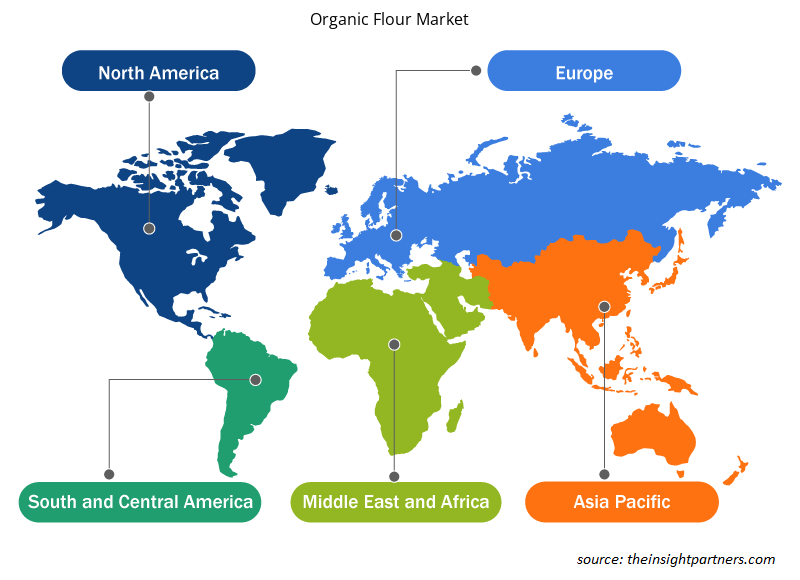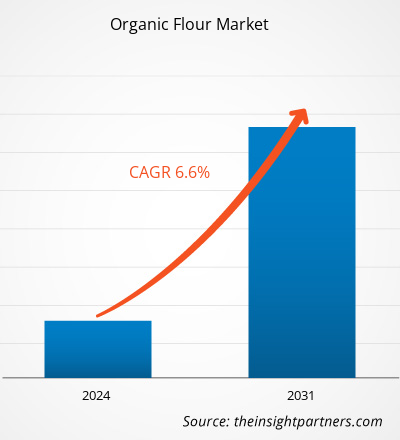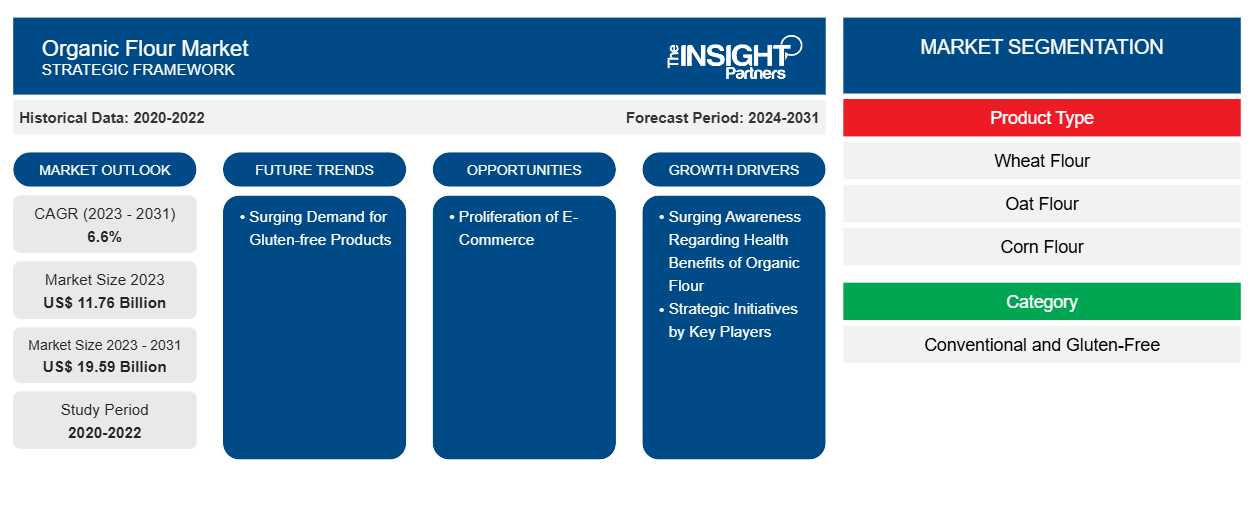有机面粉市场规模预计将从 2023 年的 117.6 亿美元增长到 2031 年的 195.9 亿美元;预计2023 年至 2031 年的复合年增长率为 6.6%。
市场洞察和分析师观点:
随着消费者越来越注重健康并寻求有机产品,对有机面粉的需求激增。有机面粉由不使用有毒农药、合成肥料或基因工程技术种植的谷物制成。由于消费者越来越喜欢更健康、更环保、更符合道德标准的食品,对有机面粉的需求激增。此外,有机食品的丰富营养价值和潜在的健康益处也促进了需求的增长。这种激增是有机食品行业大趋势的一部分,近年来有机食品行业出现了显著增长。此外,由于人们对环境可持续性的认识不断提高,许多消费者选择有机产品来支持更环保的农业实践,这些实践优先考虑土壤健康和生物多样性。此外,支持当地农民和小规模生产者并提供食品生产透明度的愿望也促进了对有机面粉的需求上升。
增长动力和挑战:
各种市场参与者为巩固其地位并利用新兴机会而采取的并购、合作、活动发布和产品发布等战略举措预计将促进有机面粉市场规模的增长。例如,2020 年,ADM 收购了英国有机面粉加工公司Gleadell Agriculture Ltd. 剩余 50% 的股份。此次收购使 ADM 扩大了其在有机面粉市场的影响力并增强了其供应链能力。旨在提高消费者对有机面粉益处的认识和教育消费者的活动也在推动市场增长方面发挥着至关重要的作用。主要参与者经常投资营销活动,强调有机面粉的营养优势、环境可持续性和质量标准。这些活动有助于创造需求、塑造消费者偏好并将有机面粉产品与传统替代品区分开来。这些活动包括数字广告、社交媒体促销和教育内容,以提高消费者对在烘焙和烹饪中使用有机面粉的优势的认识。
产品发布对于保持竞争力和满足有机面粉市场不断变化的消费者偏好至关重要。主要参与者不断创新并推出针对特定饮食需求、口味偏好和场合的新型有机面粉产品。例如,无麸质有机面粉品种迎合了麸质不耐症或敏感症消费者的需求,而杏仁粉或椰子粉等特种面粉则吸引了注重健康的消费者,他们寻求替代烘焙原料。例如,2021 年,霍奇森磨坊推出了一系列新的有机面粉,包括有机全麦面粉、有机通用面粉和有机糕点面粉,以满足寻求有机替代品满足烘焙需求的消费者的需求,并展示了霍奇森磨坊致力于满足对有机面粉选择日益增长的需求。此外,一些公司正在通过推出有机面粉等产品进入有机市场。
与有机面粉相关的监管合规性,例如美国农业部和欧盟有机法规等监管机构规定的严格标准和认证流程,预计将抑制全球有机面粉市场的增长。获得有机认证需要全面的检查、记录和遵守特定的有机农业实践,所有这些都需要生产者投入大量时间和资金。这一详尽的过程可能会对较小的生产者或资源有限的生产者产生威慑作用,阻碍他们进入或扩大有机面粉市场。
定制此报告以满足您的需求
您可以免费定制任何报告,包括本报告的部分内容、国家级分析、Excel 数据包,以及为初创企业和大学提供优惠和折扣
- 获取此报告的关键市场趋势。这个免费样品将包括数据分析,从市场趋势到估计和预测。
报告细分和范围:
“全球有机面粉市场分析”考虑了以下细分市场:产品类型、类别、分销渠道和地理位置。根据产品类型,有机面粉市场分为小麦粉、燕麦粉、玉米粉、米粉等。根据类别,市场分为传统和无麸质。根据分销渠道,市场分为超市和大卖场、便利店、在线零售等。有机面粉市场报告的地理范围集中在北美(美国、加拿大和墨西哥)、欧洲(德国、法国、意大利、英国、俄罗斯和欧洲其他地区)、亚太地区(澳大利亚、中国、日本、印度、韩国和亚太其他地区)、中东和非洲(南非、沙特阿拉伯、阿联酋和中东和非洲其他地区)以及南美洲和中美洲(巴西、阿根廷和南美洲和中美洲其他地区)。
节段分析:
根据产品类型,市场细分为小麦粉、燕麦粉、玉米粉、米粉和其他。根据类型,预计到 2030 年无麸质部分将占据有机面粉市场的很大份额。无麸质面粉专为受乳糜泻或麸质敏感症影响的个人以及选择无麸质饮食的人设计。由于麸质相关疾病的患病率不断上升以及更广泛的健康意识趋势,对无麸质声称产品的需求大幅增加。根据 Beyond Celiac 的数据,在美国,每 133 个美国人中就有 1 个,即约 1% 的人口患有乳糜泻。乳糜泻意识促使许多消费者寻求无麸质替代品,从而为迎合饮食限制的产品创造了巨大的市场。此外,无麸质选择可能更健康的观念扩大了消费者群体,除了患有疾病的人群之外,还促进了无麸质有机面粉市场的持续增长。
区域分析:
根据地域划分,市场分为五个主要区域——北美、欧洲、亚太、南美和中美以及中东和非洲。就收入而言,北美占据了全球有机面粉市场份额的主导地位。2023 年,北美市场规模约为 29 亿美元。预计在预测期内,亚太地区有机面粉市场将以最高复合年增长率增长。亚太地区正在经历快速的城市化和消费者生活方式的改变。城市消费者寻求有机面粉作为自制面包、糕点和其他烘焙食品的关键原料。此外,COVID-19 疫情等因素加速了向家庭烘焙的转变,促使更多消费者探索在家烹饪和烘焙。因此,作为一种用途广泛且营养丰富的烘焙原料,亚太地区对有机面粉的需求大幅增长,支持了市场扩张。
亚太地区拥有多样化的农业景观和传统的农业实践,为有机面粉生产提供了充足的机会。在印度、中国和澳大利亚等国家,在政府推广可持续农业和有机认证计划的政策支持下,有机农业计划正在兴起。人们对有机农业的兴趣日益浓厚,增加了该地区生产的有机谷物和面粉的供应。人们对健康和保健意识的不断增强推动了亚太地区有机面粉市场的增长。
欧洲是另一个主要贡献者,占据全球 30% 以上的市场份额。欧洲各地的消费者越来越关注食品安全、环境可持续性以及农业实践对公共健康的影响。这导致人们对有机产品(包括面粉)的偏好日益增加。欧洲消费者积极寻求不使用合成农药、除草剂或转基因生物生产的有机面粉,认为它比传统面粉更安全、更环保。这种向有机面粉的转变也受到消费者生活方式和饮食偏好变化的推动,许多欧洲人选择更健康、更天然的食品。
有机面粉市场区域洞察
Insight Partners 的分析师已详细解释了预测期内影响有机面粉市场的区域趋势和因素。本节还讨论了北美、欧洲、亚太地区、中东和非洲以及南美和中美洲的有机面粉市场细分和地理位置。

- 获取有机面粉市场的区域特定数据
有机面粉市场报告范围
| 报告属性 | 细节 |
|---|---|
| 2023 年的市场规模 | 117.6亿美元 |
| 2031 年市场规模 | 195.9亿美元 |
| 全球复合年增长率(2023 - 2031) | 6.6% |
| 史料 | 2020-2022 |
| 预测期 | 2024-2031 |
| 涵盖的领域 | 按产品类型
|
| 覆盖地区和国家 | 北美
|
| 市场领导者和主要公司简介 |
|
有机面粉市场参与者密度:了解其对业务动态的影响
有机面粉市场正在快速增长,这得益于终端用户需求的不断增长,而这些需求又源于消费者偏好的不断变化、技术进步以及对产品优势的认识不断提高等因素。随着需求的增加,企业正在扩大其产品范围,进行创新以满足消费者的需求,并利用新兴趋势,从而进一步推动市场增长。
市场参与者密度是指在特定市场或行业内运营的企业或公司的分布情况。它表明在给定市场空间中,相对于其规模或总市场价值,有多少竞争对手(市场参与者)存在。
在有机面粉市场运营的主要公司有:
- 家乡食品公司
- 鲍勃红磨坊天然食品
- 亚瑟王烘焙公司
- 柯罗
- Betterbody 食品公司
- FWP 马修斯有限公司
免责声明:上面列出的公司没有按照任何特定顺序排列。

- 获取有机面粉市场顶级关键参与者概述
行业发展和未来机遇:
有机面粉市场预测可以帮助利益相关者规划其增长战略。以下是有机面粉市场主要参与者采取的举措:
- 2022 年,以 Amul 品牌销售产品的乳制品巨头 GCMMF 宣布进军有机食品市场,推出有机小麦粉。该组合推出的第一款产品是“Amul 有机全麦面粉”。
竞争格局和重点公司:
Hometown Food Company、Bob's Red Mill Natural Foods、Betterbody Foods C/O、FWP Matthews Ltd、Shipton Mill Ltd、W and H Marriage and Sons Limited、Gilchesters Organics 和 Anita's Organic Grain & Flour Mill Ltd. 是有机面粉市场报告中介绍的知名企业。在全球市场运营的企业专注于提供高质量的产品以满足客户需求。他们还采用各种策略,例如新产品发布、产能扩张、合作伙伴关系和协作,以保持市场竞争力。
- 历史分析(2 年)、基准年、预测(7 年)及复合年增长率
- PEST和SWOT分析
- 市场规模、价值/数量 - 全球、区域、国家
- 行业和竞争格局
- Excel 数据集
近期报告
客户评价
购买理由
- 明智的决策
- 了解市场动态
- 竞争分析
- 客户洞察
- 市场预测
- 风险规避
- 战略规划
- 投资论证
- 识别新兴市场
- 优化营销策略
- 提升运营效率
- 顺应监管趋势























 获取免费样品 - 有机面粉市场
获取免费样品 - 有机面粉市场